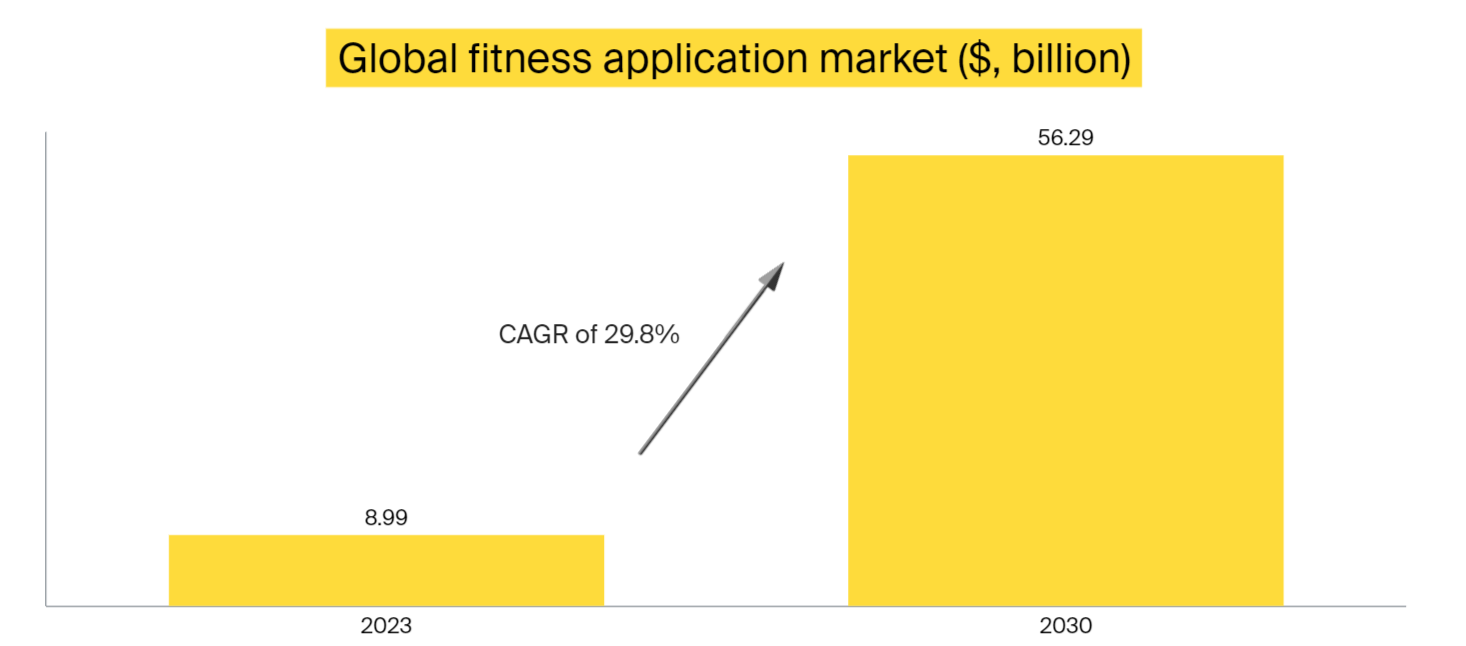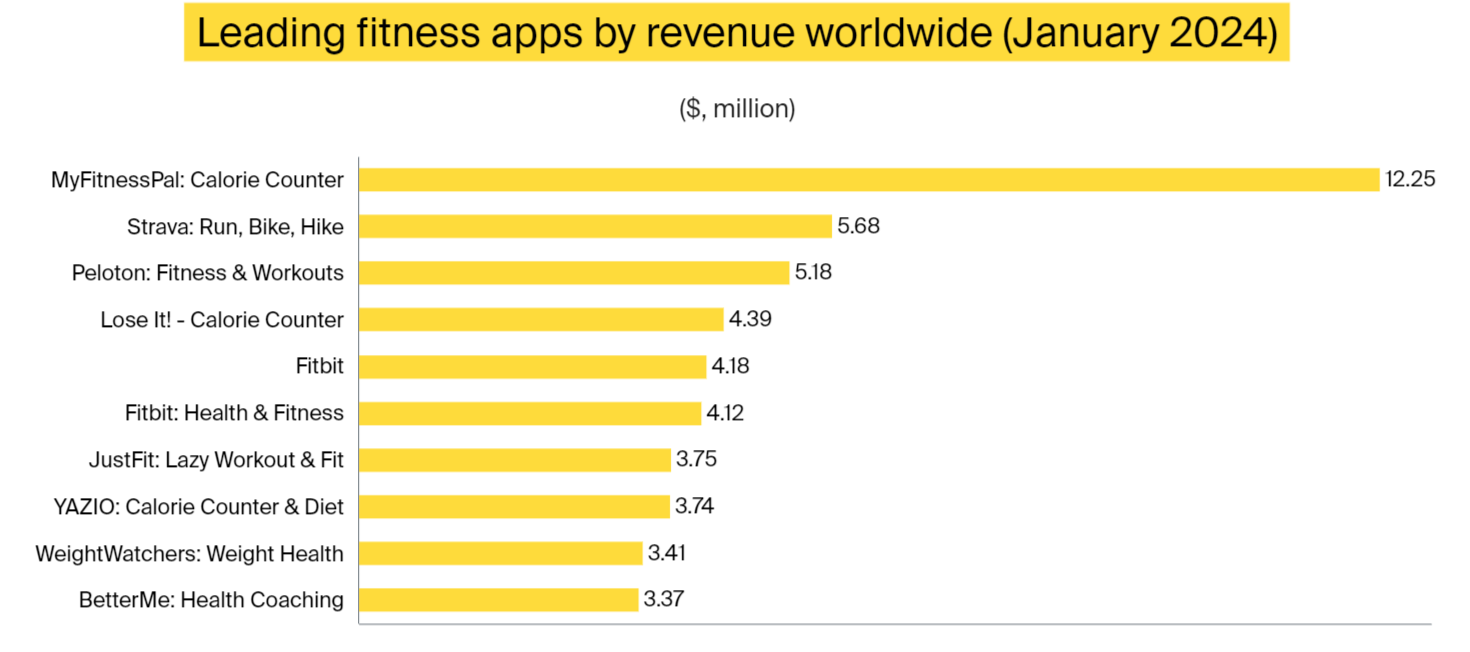The fitness landscape has evolved dramatically, with at-home workouts becoming the leading trend in 2022 and maintaining their popularity in 2024. Recent surveys indicate that Americans now prefer home gyms over traditional gym memberships.
As the fitness app market expands rapidly, sports industry leaders are hiring fitness app development companies to stay competitive. Valued at $8.99 billion in 2023, the global fitness app market is projected to soar to $56.29 billion by 2030, with a staggering CAGR of 29.84%.
Clearly, the demand for fitness apps is booming. But what about their profitability? When equipped with essential functionalities, user-friendly interfaces, and appealing designs, fitness apps can be highly lucrative. Take a look at the impressive performance of some top fitness apps for evidence.
If you’re ready to join the ranks of fitness tech leaders, developing a mobile app is crucial. This article will help you estimate how much it costs to build a fitness app.
How much does it cost to create a fitness app? This depends on the following factors
There are seven main factors that influence fitness app development costs:
- Application type
- Feature
- Integration with external services
- Design complexity
- Platform and tech stack
- Development team composition
- Technical support and updates
1. Application type
Workout apps
This type of fitness applications enables users to select their own exercise routine. Normally, workout regimens presented on the app are not customized but offer useful information on each exercise, like which muscle group is activated and how many calories are burned. This helps users make informed decisions and select suitable exercises to include in their routine.
Some workout apps act like a fitness coach and present personalized workouts based on user parameters and desired results. One such example is MyCoach app that has a million downloads across 25 countries.
Such fitness apps cost upwards from $100,000.
Nutrition and diet apps
A balanced diet is an essential part of staying fit. Nutrition software enables users to keep track of food they consume throughout the day, count calories, and log microelements. One example of such an app is MyPlate Calorie Counter.
Nutrition and diet applications can also propose a meal plan based on the user’s parameters and objectives (e.g., losing weight, building muscle, etc.) while adapting to the person’s current eating preferences—vegan, vegetarian, keto, intermittent fasting, etc.
Another type of diet apps focuses on social networking, enabling users to connect with professional dietitians and share their recipes and success stories. One example is the Mealshare app developed by Estonia-based Perpetio.
Fitness diet apps’ price tag also starts at $100,000.
Activity tracking apps
These fitness solutions track your physical activities, such as the number of steps per day or running and cycling distance and speed. One example is Adidas Running by Runtastic.
Activity monitoring applications often connect to wearable devices that can measure heart rate, blood pressure, and other health parameters.
The costs required to develop such fitness app start from $140,000.
Meditation and yoga apps
This set of mental health apps contains yoga workouts, tutorials on how to get into different poses correctly, guided meditation practices, etc.
One example is the widely-used Daily Yoga app that offers over 50 workout plans and allows users to connect to a yoga community, share their experience, and gain inspiration. For meditation and mindfulness, users can try Headspace, which helps you relax and clear your head before going to sleep. This app has over 70 million downloads.
The costs of developing such fitness app start at $100,000.
AI-powered coaching app
AI-driven fitness applications use data analytics and machine learning to offer tailored coaching recommendations and help people achieve their personal fitness goals. These solutions can create customized workout plans, encourage daily check-ins, monitor progress by analyzing data from wearable devices, and take a comprehensive approach to wellness considering the person’s medical history and current health status.
Some AI-powered coaching apps use dedicated technology to monitor and correct user form. For instance, MotionMind is an innovative AI-based technology that can accurately estimate human pose during exercise and notify the user upon detecting poor form. This technology can be integrated with any fitness app, providing accurate pose estimation and guidance with any camera setup.
A fitness app with simple AI capabilities can cost anywhere from $150,000.
Companion app
Some apps are developed specifically for one fitness device vendor. They connect with the equipment and enhance its functionality. For instance, Perpetio built a fitness app that connects to treadmills of a specific brand. This solution not only tracks users’ activities on the treadmill but also allows them to communicate, share their performance metrics, and participate in different challenges.
The cost of this app type starts at $140,000 and covers integration with the device.
2. Set of features
How much your fitness app costs largely depends on its functionality. The more features you want to incorporate, the more time and money you will need to invest, but also the more valuable your app will become. Some basic features, such as social sharing, will take a few hours to implement, while more complex functionality like user registration can take days. If a feature takes specialized skills to implement, it will affect the price even more.
Here is a list of core functionalities that are a must in almost every fitness software solution:
-
Registration and login. You might want to give users the option to sign up using Google or any other existing account. In addition to regular user information, such as name and age, you will need to include fitness-specific fields, like weight and height. Also, ask for an email and a phone number to provide several verification options. If users protect their account with a password, make the password recovery option readily available. Registration and login features will cost you around $15,000.
-
Notifications and reminders. This can include a notification on when to start exercising or when to switch to another exercise. If your app is connected to a smart watch, you might redirect the notifications there. Users will find it more convenient to start a new set of reps when they feel a vibration on their wrist instead of looking at the phone screen. Setting up notifications and reminders will cost you around $3000–$5,000
-
Settings. This feature allows users to customize their app’s appearance and functionality. So, the app needs to have default settings as well as an opportunity for users to tweak them to add a personal touch. Building the settings feature for your fitness app will cost you around $5,000.
-
Workout catalog with exercise videos that can be streamed live or available on demand. For this feature, you will pay around $2,000 if you just need a user interface and the video content is already published on YouTube, for instance.
If you study your direct competitors, you might discover other useful features that you can incorporate into your solution. You could also identify some functionality that your rivals’ apps are missing and implement it to gain a competitive advantage.
You can consider the following advanced features for inspiration:
-
Integrating with wearable devices. You might connect your app to a smartwatch or other sensors that can read and stream user data. This feature will cost you anything from $10,000 if the integration is supported by HealthKit or Android Health, and you will pay at least $30,000 for a custom SDK.
-
Incorporating innovative technologies, such as artificial intelligence and augmented reality. This will significantly increase your fitness app development costs. For instance, if you want to add a recommendation system trained on user behavior, this alone will cost you around $20,000 for a simple integration, and it will take many hours to label the training dataset and train the model.
-
Gamifying the app. Gamification means your app can assign scores, measure progress levels, assign rewards, etc.—anything that makes exercising feel like a game or a competition. Gamifying your solution can cost you up to $12,000.
-
Integrating with social media. If your clients are avid social media users, they will love this feature as it allows them to share their achievements, personal records, motivational quotes, and other relevant aspects of their workout with their network. You can spend $500—$6,000 on social media integration, depending on the integration path and the number of channels.
-
Calendars to let users schedule their workouts and maybe even share their workout calendar with friends so that others can join in. This will cost you at least $10,000 to integrate an existing calendar solution.
-
Online chatting and video streaming functionality to let users exercise together. For this option, you can expect to pay at least $10,000.
-
Educational material, such as tips from professional trainers, a blog with relevant posts, etc. Content integration will cost you from $5,000, depending on content type.
-
Maps and geolocation, which is an important feature for activity tracking apps. It can display the user’s route on a map and even present weather forecasts and air quality details. This functionality costs around $5,000.
-
Payment options. It’s a good practice to integrate an existing secure and reliable payment gateway, such as PayPal, with fitness applications. Giving several options will be beneficial so that users don’t abandon your app because they can’t use your payment method. For each payment option, expect to spend around $10,000.
3. Integration with external services
While you are building your product, you might opt for integrating third-party libraries and interact with payment gateways and web services. For instance, if you want to collect customer feedback, there is an existing code that will do the trick. This will decrease your fitness app’s development costs and reduce time to market. But this practice might open security vulnerabilities if you use open-source code. If you choose a proprietary technology, you might become over-reliant on a third party vendor subscription fees, which might grow along with your user base.
You might also need to integrate your product with external devices, such as wearable sensors or a camera, and with existing platforms like social media. For each of these integrations, you can pay at least $10,000 depending on whether the device and protocol are standard or custom.
4. Design complexity
Your solution’s user interface complexity and uniqueness directly affect how much it costs to build this fitness app.
If you simply want to make minor adjustments to an existing template, then your designer can get the work done in approximately 40 to 50 hours. But if you are looking to build something creative, intuitive, and user-friendly that can set your brand apart from the competition, then user interface design will be a large segment of the development process.
Your design complexity increases with the following features:
-
Complex animation
-
Interactivity
-
Compatibility with different devices, such as tablets, smartwatches, etc., and screen resolutions
-
Integration with voice assistant
-
Incorporating augmented reality
Note that you need both an attractive design and reasonable speed. If your animation takes too long to load, users are more likely to despise it than appreciate it.
5. Platform and tech stack
If you are creating a mobile fitness app, there are two popular platforms—Android and iOS. If you choose to use native development technologies to build two separate apps, this will increase your average fitness app costs, since there will be two code bases. But there are some steps that you will only make once. For instance, there will be one unified design and look-and-feel for your application on both platforms.
Unless your app is specific to one platform, it’s a good idea to opt for cross-platform app development services that use technologies such as Flutter and Xamarin. These tools enable developers to create one source code, which they will compile into native code for different platforms. This approach can minimize the time and effort needed to create both apps by around 40%. But this technology might not suit complex projects. Also, some argue that native solutions provide a superior user experience.
For cross-platform development with gamification and complex graphics, you can use game engines, such as Unity or Unreal Engine.
Here are average hourly rates in the US from ZipRecruiter for cross-platform, Android, and iOS app development services for comparison:
| Android developer | iOS developer | Flutter developer (cross platform) | |
|---|---|---|---|
| Hourly rate |
$10.82—$83.41 |
$10.34—$86.06 |
$10.58—$73.56 |
6. Fitness app development team
To build your fitness app, you either assemble an in-house team or outsource the development to a dedicated team of professionals
-
In-house development team allows you to maintain reliable communication with the members, but it’s a more expensive option as you are responsible for hiring, renting offices, acquiring equipment, etc. It can cost you $30,000 and take 42 days to hire one app developer. And there is always the risk that people you end up hiring lack the essential skills to complete the project.
-
Outsourcing the development process is an alternative where you only pay for the work accomplished. No need to bother with rentals, interviews, last-minute replacements, and other administrative stuff. This model decreases the investment costs needed to build a fitness app.
>You can also combine both approaches by using an in-house team and outsourcing particular expertise that you can’t fill internally. For instance, you can use the CTO as a service model.
An app development team must include at least one UI/UX designer, QA engineer, project manager, and, of course, programmers who can code in a native or a cross-platform language. On our blog, you can learn more about software development team structures and the roles of every member.
| Average hourly rate in the US (ZipRecruiter ) | The degree of commitment to the project | |
|---|---|---|
| UI/UX designer |
$54 |
Full time at early stages, then in a supporting role for a few hours per week |
| QA engineer |
$49 |
Full time |
| Mobile app developer |
$55 |
Full time |
| Backend developer |
$58 |
Full time |
| Product owner |
$113 |
5-10 hours/week |
| Project manager |
$59 |
0.5 FTE |
Talent costs vary greatly based on their geographical location. Some countries have higher salary expectations than others. It can cost you almost three times as much to hire a US-based developer compared to a professional located in Asia. But if you recruit someone from a different country, communication issues might arise. You will need to make sure you are on the same page when it comes to work standards and ethics. Below is an example of how developers’ hourly rates vary from one country to another.
| US | Western Europe | Eastern Europe | Asia | |
|---|---|---|---|---|
| Average software development hourly rates* |
$77 |
$75 |
$58 |
$28 |
| Ease of doing business according to The World Bank (the score is out of 100) |
84 |
80,3 |
73,7 |
65,5 |
*Source: YouTeam, 2024
7. Technical support and updates
The expenditures don’t stop the moment you launch the fitness app. Think about how you will monitor performance, implement updates, and deliver customer support.
As the app’s audience grows, you will need to ensure the performance doesn’t degrade. You might also want to include new features to keep surprising and engaging your clients. But this new functionality can create bugs and open security vulnerabilities, so you have to constantly test your solution.
With an in-house development team, technical support will not be an issue. But if you hired an external tech partner, then ideally, they should take over support and updates. If this is not possible, ask for detailed technical documentation that will support the party taking over this duty. It is advisable to dedicate approximately 15-20% of your fitness app’s development costs to maintenance.
How much does a fitness app cost? Numbers from real-life projects
Activity tracking fitness app

Below are the most prominent features of the app:
-
GPS tracking to monitor user location
-
Search function to find and join relevant communities
-
Analytical component that can process user location and activity data
-
Strava API for fetching physical activity data
Project duration: 2.5—3 months
Development costs: from $100,000
Team composition: one developer
App development phases: software engineering
Android tech stack
| Programming language |
Kotlin |
| Android libraries/frameworks |
Android SDK, Retrofit, RxKotlin, Google Play Services, Custom View, Fabric, Firebase, Appflyer, Glide, Koin, Branch, SDK generated by API Gateway |
| AWS |
Amazon S3, Amazon DynamoDB, Amazon Secure Endpoints |
| Testing tools |
Espresso, Mockito, JUnit |
| Tools |
Android Studio, Zeplin, Jira, Bitbucket |
Coach-in-a-pocket fitness application for smart training
-
Recommending training programs based on user parameters, such as age and fitness level
-
Allowing users to manage and modify fitness and nutrition programs, change dates, and add and delete workout plans
-
Offering training tips and videos based on the selected training program
-
Tracking progress and offering achievement overview
-
Suggesting meal plans
-
Option to take quizzes
-
Integration with social media to share progress
-
Creating a library of webinars and exercise videos
Project duration: 10—12 months
Development costs: $300,000—$450,000
Team composition: iOS developer, Android developer, front-end developer, back-end developer, QA engineer, DevOps, business analyst, project manager.
App development phases: software engineering
Technology used
| Front-end programming |
Typescript, React, redux, redux-toolkit, styled-components, material-ui, CRA, react-admin |
| Back-end programming |
PHP, Laravel |
| iOS app |
Swift 5.0, UIKit + AutoLayout, Lottie, Alamofire, Stripe SDK |
| Android app |
Kotlin 1.4, RxJava, Dagger, Retrofit, Stripe SDK |
| Databases |
MySQL |
| Cloud storage options |
AWS |
| Payments Gateways |
Native In-app purchase from Apple and Google |
A companion app for an AI-powered fitness mirror with a personal coach

A North American startup wanted to build a mirror that people can use to exercise at home under the supervision of a virtual coach that will monitor their posture, offer custom workout plans, and encourage them to perform to the best of their abilities. Here are the main components of this project:
-
A full-length physical mirror with a custom operating system equipped with sensors to monitor the user’s posture
-
IoT sensors that users can stick to their equipment, making it part of the training system
-
Camera and computer vision technology for motion tracking and rep counting
-
ML model, which can learn the physical abilities of every user, offer encouragement and training tips, and recommend workout plans
-
Voice control system that understands a set of spoken commands
-
A custom fitness Android/iOS app to interact with community members
-
Admin panel to enable fitness trainers to upload their content and give exercise tips
The companion app’s key features include:
-
Interacting with the mirror. Through the app, users can open and close workouts, put on music, and retrieve statistics on their training progress.
-
The app allows a smartphone to act as a remote keyboard
-
Sharing training results on social media
-
Exchanging messages with a human trainer
Project duration: 4.5 months
Development costs: $130,000—$160,000
Team composition: three developers
App development phases: software engineering
Technology used
| Android |
AOSP, Kotlin |
| iOS |
SWIFT |
| Back-end development |
Java, Kafka, Spring Framework/Boot/Cloud, Firebase, Jenkins |
| Front-end development |
React, Redux |
| Artificial intelligence |
TensorFlow, OpenCV |
| Testing |
Appium, Selenoid |
| Cloud storage options |
AWS |
| Database |
PostgreSQL |
| Communication protocols |
Bluetooth, Wi-Fi, WebSocket |
Fitness app development with ITRex
If you choose to partner with ITRex, we will help you conceptualize and build a successful fitness solution in four steps. Allocating enough time to each phase will help you reduce the overall fitness app development costs.
Discovery
Our comprehensive product discovery phase includes idea validation, formalization, and design. In the end, you will receive detailed documentation of your product idea, accompanied by a high-fidelity prototype.
Business idea validation
As the first step, we use the Lean Canvas method to test your business idea for viability. With this method, we will investigate the market needs, clarify your unique value proposition, study the audiences’ willingness to pay for the fitness application, outline the channels you will use to reach customers, describe the risks, and more, all on a single page.
By succinctly documenting these components, Lean Canvas allows you to quickly test and refine your concept with real market feedback.
Formalization
Now is the time to formalize and structure your project. Together, we can go through the following steps:
-
Write down and elaborate on the requirements and the features that you want to include. Find out more on this topic in our comprehensive requirements specification guide.
-
Choose the tech stack that suits the purpose at hand
-
Let QA engineers review your specifications to ensure they are free of logical mistakes
-
Estimate time and finances needed to build such an app
Even though this phase might seem tedious and time-consuming, it will cut down on your fitness app building costs as you progress to design and development.
Design
Our creative UI/UX designers will work with you to prepare a compelling prototype of your fitness app. They will take you through the three steps presented below and repeat the user testing step when needed.
-
Wireframing and prototyping. A prototype allows you to see the functionality in action. It brings wireframes to life by implementing the app’s look-and-feel and making the frames clickable to resemble the interaction with the actual app.
-
User testing. During this step, a group of actual users, representative of your target audience, interact with the prototype to verify whether it’s intuitive and user-friendly. We will use the feedback to further improve your solution.
-
Creating high-fidelity mockups. A high-fidelity mockup is a detailed and realistic representation of a product’s design, closely resembling the final version in terms of layout, color, typography, and functionality. These mockups include specific visual elements, interactive components, and accurate spacing, giving a clear preview of your fitness app’s user interface.
Phase duration: 120—400 hours
Development
During this phase, our developers will build the actual fitness app. They will connect the app to the back end and integrate it with all the other components, like payment gateways and social media platforms. While building the solution, the team will answer the following questions:
-
Which components can we reuse to cut down on fitness app development costs?
-
Which components do we need to integrate? Google Fit, Apple Health, etc.
-
How do you make this application secure?
-
What are the regulations on data privacy? Are we compliant?
To minimize fitness app development costs and time to market, we can start by creating a minimum viable product (MVP), which is limited to the core functionality. You can launch the MVP and monitor how users interact with it, what they dislike, and what is missing, so you can improve the product gradually. If the MVP performs well on the market, you can use its success to negotiate additional funds with investors.
Phase duration: 400 hours—as long as it takes
Quality assurance and testing
Our quality assurance engineers will test the mobile application for bugs and make sure it’s compliant with requirement specifications and with the country’s regulations. You can also focus on reviewing and refactoring the code to increase speed and stability.
Phase duration: 120 hours—as long as it takes
Rollout
When the fitness solution is ready, you are likely to publish it on the App Store and/or Google Play and let users download it from there. In the meantime, don’t sit idle. Work on spreading the word about your application. Users can’t download it if they don’t know it exists. Here are a few tactics that can help you promote your product:
-
Make a social media announcement
-
Advertise the app on relevant websites. You can author a promotional blog post or a paragraph on a news aggregator website.
-
Benefit from paid advertisement on YouTube, Google, etc.
-
Reach out to fitness influencers and ask them to review or just mention your app on their platform
As you publish and market your app, our team is available for maintenance, support, and improvements. You can monitor user feedback and app usage stats and make adjustments so that your app remains relevant and exciting.
This phase is a continuous process.
How to speed up the fitness app development process: tips from ITRex
-
Don’t skip the discovery phase. During this stage, you can uncover some aspects that could hinder development in the future. For example, you can realize that you need additional research or that budget estimates are inadequate. It also helps you prepare for potential risks.
-
Use an incremental approach to development. Start with MVP and add features gradually.
-
Dedicate time to build solution architecture. Take non-functional requirements into account. A solid architecture will make your app more reliable and resilient. For example, a well thought-out architecture will allow your solution to scale as your user base grows.
-
Decrease your time to market. This way, you will start receiving meaningful feedback as soon as possible, and could improve your product faster.
-
Automate. This might not be feasible for small-scale solutions, but for a project with 500+ hours of development and QA, automate testing as much as possible.
Takeaways
So, how much does it cost to make a fitness app? Anywhere from $100,000 for basic functionality and modest design. If you want to incorporate custom animations and innovative technologies, such as AI, the costs will grow exponentially.
You can get a more precise estimate after reviewing all the factors presented in this article and tailoring them to your case. Don’t forget to include a buffer for costs you will incur along the way. For example, to publish your fitness app on an app store, you will need to pay fees. Google Play charges a onetime $25 fee while Apple Store will collect $99 annually. These platforms also take commissions for each app purchase.
And keep in mind that app development is a continuous expenditure. After releasing your product, you will still have to fix bugs, incorporate updates and new features, and provide customer support. Partnering with a trusted software development partner like ITRex will help you reduce app development costs in the long run and increase your app’s reliability and appeal.
















